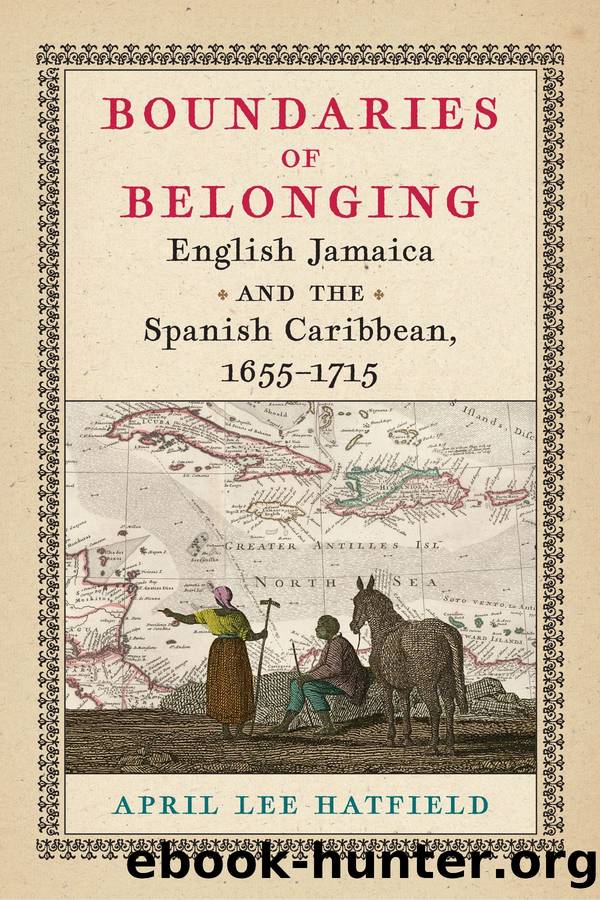Boundaries of Belonging by April Lee Hatfield;

Author:April Lee Hatfield;
Language: eng
Format: epub
ISBN: 9781512824025
Publisher: Lightning Source Inc. (Tier 2)
Published: 2022-11-03T00:00:00+00:00
Freedom draws such, and where thereâs many found,
It is most certain, Riches will abound.
One hundred such, ten thousand do imploy,
Who find their Wealth increase, but know not Why
The author, who knew that the Company of Scotlandâs plan focused on Darién, reiterated that unfettered commerce would provide ample employment and plenty for all.37
A 1696 promotional pamphlet likewise revealed both confidence in and wonder at the promises of global commerce: âthere is such a Mystery in Trade, that Trade createth Trade, and one Trade createth another, and encreaseth another.â38 That was why Paterson saw the isthmus, along with Havana, where ships assembled before crossing the Atlantic for Europe, as the âdoors of the seas and the keys of the universe.â39 The metaphors of door and key that he used were not original. But Paterson expanded on the imagery when he called Panama and Havana the keys not only to the oceans, the Indies, or the world, but even to the universe, emphasizing the cosmic power he saw in global trade. It could lift onto a new plane that part of humanity that could claim membership in the trading world.
Paterson believed the Scottish colony would make the world more just and humane as well as more wealthy. He argued that controlling the isthmus would allow the Scots to âgive laws to both oceans, and to become the arbitrators of the commercial world.â40 The most straightforward interpretation of the impulse to âgive lawsâ is that it signaled a desire to exert power, and indeed the goals seem consistent with contemporaneous imaginings that an absolute monarch might conquer the world. But in the context of Patersonâs essay, âto giveâ is also consistent with the bestowal of a gift. The economic hegemony afforded by a Darién-based colony would allow the company to rule the world peacefully, âwithout . . . contracting the guilt and blood of Alexander and Caesar.â41 Britons very much believed in the superiority of their own laws âto distribute Justice, and defend Liberty and Property,â as Roderick MacKenzieâs 1695 pamphlet had emphasized.42
Patersonâs fantasy of wealth without âguilt and bloodâ ignored the violence of the transatlantic slave trade that underpinned his plans.43 Company discussions of potential settlement locations repeatedly mention the desire to find a place that would allow them to sell enslaved Africans to various European colonists, including Spaniards.44 When he proposed global commerce as a cure for poverty, Paterson thus excluded African laborers from the beneficiaries. Rather, they figured in his equation as nearly invisible producers of trade goods (âthe labouring man in Americaâ), and as merchandise themselves.45 His views epitomized a British ability to envision colonization as universally beneficial because they presumed a âuniverseâ that did not include people who were commodities rather than commodifiers.
The 1697 âPoem Upon the Undertaking of the Royal Company of Scotlandâ unapologetically linked the creation of wealth via free trade with the enslavement and forced labor of African captives:
Download
This site does not store any files on its server. We only index and link to content provided by other sites. Please contact the content providers to delete copyright contents if any and email us, we'll remove relevant links or contents immediately.
| Antigua | Bahamas |
| Barbados | Cuba |
| Dominica | Dominican Republic |
| Grenada | Haiti |
| Jamaica | Saint Kitts |
| Saint Lucia | Saint Vincent |
| Trinidad and Tobago |
Cat's cradle by Kurt Vonnegut(14757)
Pimp by Iceberg Slim(13777)
Underground: A Human History of the Worlds Beneath Our Feet by Will Hunt(11836)
4 3 2 1: A Novel by Paul Auster(11788)
The Radium Girls by Kate Moore(11621)
Wiseguy by Nicholas Pileggi(5315)
American History Stories, Volume III (Yesterday's Classics) by Pratt Mara L(5133)
Perfect Rhythm by Jae(5070)
The Fire Next Time by James Baldwin(5016)
Paper Towns by Green John(4796)
Pale Blue Dot by Carl Sagan(4613)
A Higher Loyalty: Truth, Lies, and Leadership by James Comey(4550)
The Mayflower and the Pilgrims' New World by Nathaniel Philbrick(4277)
The Doomsday Machine by Daniel Ellsberg(4245)
Killers of the Flower Moon: The Osage Murders and the Birth of the FBI by David Grann(4188)
The Sympathizer by Viet Thanh Nguyen(4093)
Too Much and Not the Mood by Durga Chew-Bose(4090)
The Borden Murders by Sarah Miller(4013)
Sticky Fingers by Joe Hagan(3911)
